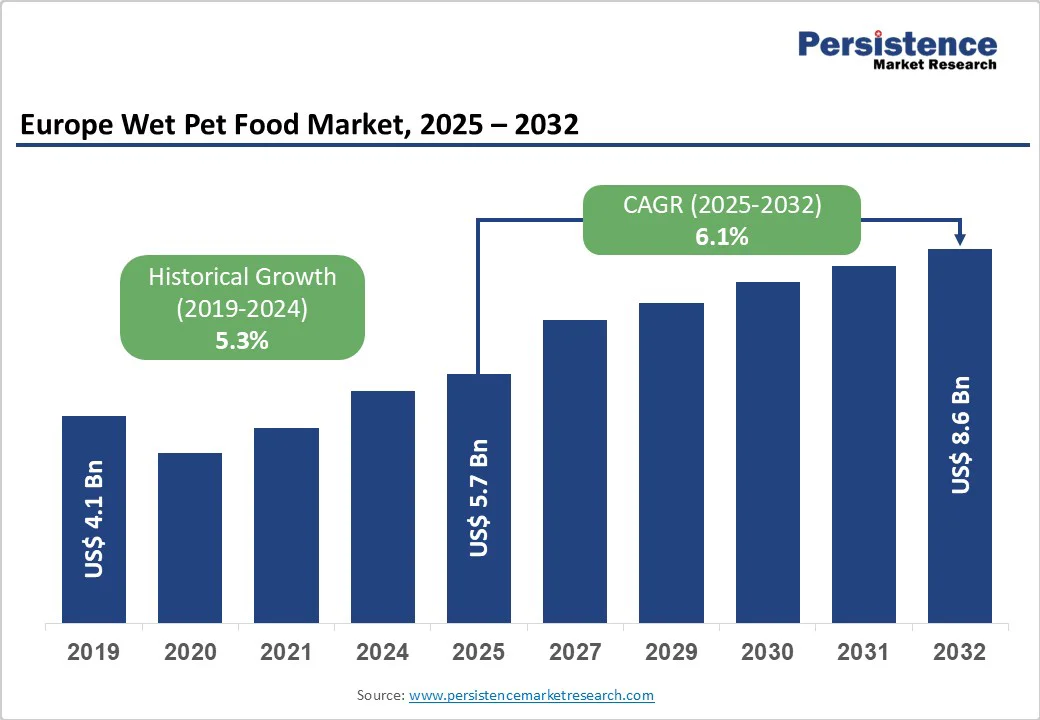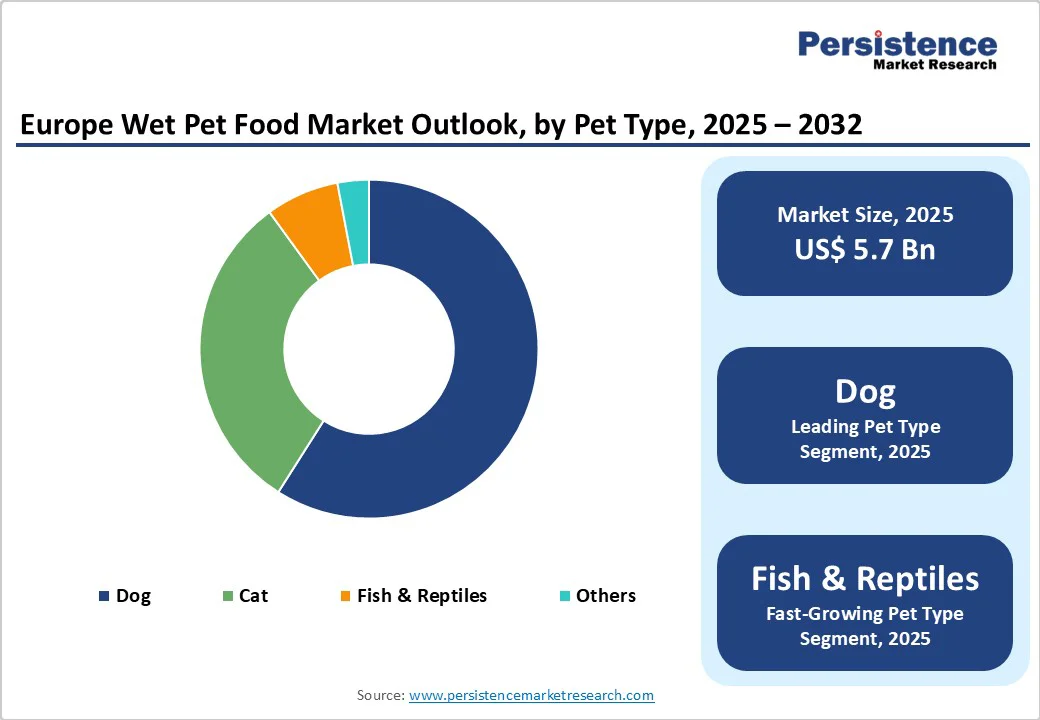ID: PMRREP35698| 176 Pages | 8 Oct 2025 | Format: PDF, Excel, PPT* | Food and Beverages

Europe Wet Pet Food market size is likely to value US$ 5.7 billion in 2025 and projected to reach US$ 8.6 billion by 2032, growing at a CAGR of 6.1% during the forecast period from 2025 to 2032.
| Key Insights | Details |
|---|---|
|
Wet Pet Food Market Size (2025E) |
US$ 5.7 Bn |
|
Market Value Forecast (2032F) |
US$8.6 Bn |
|
Projected Growth (CAGR 2025 to 2032) |
5.3% |
|
Historical Market Growth (CAGR 2019 to 2024) |
6.1% |

Europe’s wet pet food market is increasingly influenced by the growing trend of pet humanization, reflecting a shift in how consumers perceive and care for their animals. According to a Persistence Market Research (PMR) study, over 64% of Europeans treat their pets with the same care they would a child, highlighting the emotional bond driving premiumization and specialized nutrition.
Pet owners are seeking products that align with human food trends, including natural ingredients, functional benefits, and ethically sourced components. This has led to a surge in demand for wet foods with high-quality proteins, tailored formulations for age or breed, and innovative flavors that appeal to pets’ palates. Brands are responding with personalized diets, health-oriented recipes, and clean-label options to meet these expectations. The humanization trend presents a significant growth opportunity for manufacturers, enabling differentiation through innovation, quality, and a deeper connection with pet owners across Europe.
Volatility in raw material prices is a persistent challenge for the European wet pet food market, directly impacting production costs and profit margins. Ingredients such as meat, fish, poultry, grains, and specialty proteins are subject to fluctuations due to seasonal availability, geopolitical tensions, and global supply chain disruptions. Rising costs of high-quality proteins and sustainable ingredients can squeeze manufacturers' margins, especially those offering premium or functional wet foods.
Companies are compelled to balance ingredient quality with affordability while maintaining nutritional and sensory standards. Additionally, sudden spikes in transportation and energy costs exacerbate overall production expenses. To mitigate these risks, manufacturers are exploring long-term supplier contracts, alternative protein sources, and optimized formulations to enhance their sustainability. Effectively managing ingredient price variability is critical for sustaining profitability and ensuring competitive pricing in a market where consumer expectations for quality and consistency remain high.
An emerging opportunity in Europe’s wet pet food market lies in grain-free and allergen-free formulations, catering to the increasing number of pets with dietary sensitivities. As awareness of pet food intolerances grows among European pet owners, demand for products that support digestive health and minimize allergic reactions is rising. Grain-free wet foods, often based on novel protein sources such as fish, duck, or insect protein, provide alternatives for pets that struggle with common allergens like wheat or corn.
Allergen-free recipes also address concerns over artificial additives and preservatives, aligning with the broader clean-label movement in pet nutrition. Manufacturers can capitalize on this trend by developing tailored formulations for specific breeds, life stages, or health conditions, enhancing both palatability and nutritional value. By addressing these niche dietary needs, wet food producers can strengthen brand loyalty, tap premium segments, and differentiate themselves in a competitive European market.
Dogs hold 59% market share in Europe’s wet pet food market, making them the dominant segment by pet type. This leadership is driven by the strong emotional bond between owners and their dogs, which fuels demand for high-quality, nutritious, and palatable wet foods. European consumers increasingly treat dogs as family members, seeking products with natural ingredients, functional benefits, and tailored formulations for age, size, and health conditions.
Premiumization trends, including grain-free, allergen-free, and fortified recipes, further boost consumption, while innovative flavors and textures enhance palatability and appeal. Pet owners are also influenced by clean-label and sustainable sourcing initiatives, prioritizing products that align with ethical and environmental values. The consistent demand for dog wet food across households positions this segment as a key driver for growth, innovation, and investment within Europe’s broader pet food landscape.
Plant-based wet pet food in Europe is expected to grow at an 8.9% CAGR during the forecast period 2025–2032, reflecting a rising shift toward sustainable and health-conscious pet diets. Increasing awareness among pet owners about environmental impact, animal welfare, and plant-based nutrition is driving demand for alternative protein sources such as peas, lentils, chickpeas, and algae. These formulations provide essential amino acids and nutrients while reducing reliance on traditional meat-based ingredients. Innovations in flavor, texture, and fortification are enhancing palatability and nutritional balance, making plant-based wet foods appealing to dogs and cats alike. Clean-label certifications and allergen-free options further strengthen consumer confidence. With European pet owners prioritizing ethical, sustainable, and functional nutrition, plant-based wet pet food is poised to become a rapidly expanding segment, offering manufacturers opportunities for product diversification and premium positioning in a competitive market.

Germany’s wet pet food market is witnessing robust growth, driven by a large pet-owning population and evolving consumer preferences. According to The German Pet Trade and Industry Association (ZZF), there are approximately 10.5 million dogs and 15.7 million cats in the country, creating strong demand for high-quality pet nutrition. The largest pet retailers, Fressnapf and Zooplus, play a key role in expanding product availability and accessibility. German pet owners increasingly prioritize natural, grain-free, and allergen-free wet foods, alongside functional formulations supporting digestive health, mobility, and immunity.
Sustainable sourcing, ethical ingredients, and clean-label certifications are shaping purchase decisions, while premium and gourmet offerings are gaining traction. Convenience-driven formats, such as single-serve cans and pouches, cater to busy lifestyles. These trends position Germany as a strategic and dynamic market for innovation in wet pet food.
The UK wet pet food market is evolving rapidly as pet owners increasingly seek premium, functional, and ethically sourced options for their companions. Leading brands such as Mars Petcare, Nestlé Purina, and Royal Canin are driving innovation through nutrient-rich formulations, grain-free recipes, and protein-focused wet foods for dogs and cats. Consumers have shown growing interest in humanization trends, treating pets as family members and demanding products with natural ingredients, clean labels, and transparency in sourcing.
Single-serve pouches and portion-controlled cans are gaining popularity for convenience and freshness. Functional wet foods targeting digestive health, weight management, and joint support are on the rise, reflecting a wellness-oriented approach. The UK market also sees expansion in plant-based and hypoallergenic options, highlighting a commitment to sustainability, ethical practices, and meeting diverse dietary needs of pets across the region.
Innovation and consumer-centric strategies are shaping the competitive landscape of the UK wet pet food market. Companies are emphasizing flavor and taste development to create recipes that are both palatable and nutritionally balanced. Significant R&D investments support high-protein formulations, functional benefits, and clean-label ingredients that resonate with health-conscious and ethically minded pet owners.
Expansion of online retail and direct-to-consumer channels allows established players and agile startups to reach niche audiences effectively. Marketing efforts highlight sustainability, transparency, and pet humanization, strengthening brand loyalty. Startups capitalize on speed-to-market and novel formulations, while larger manufacturers reinforce omnichannel presence across retail, e-commerce, and subscription services.
Europe wet pet food market is projected to be valued at US$ 5.7 Bn in 2025.
Rising consumer interest in pet humanization drives European Wet Pet Food market.
Europe market is poised to witness a CAGR of 6.1% between 2025 and 2032.
Opportunity in developing grain-free and allergen-free wet foods for pets with dietary intolerances represents a significant growth avenue for players in the Europe Wet Pet Food market.
Nestlé S.A., Mars, Incorporated, Hill's Pet Nutrition, Inc., General Mills, Edgard & Cooper, Symply Pet Foods Ltd, Farmina Pet Foods, Wellness Pet, LLC are some of the key players in the market.
| Report Attribute | Details |
|---|---|
|
Historical Data/Actuals |
2019 - 2024 |
|
Forecast Period |
2025 - 2032 |
|
Market Analysis |
Value: US$ Bn |
|
Geographical Coverage |
|
|
Segmental Coverage |
|
|
Competitive Analysis |
|
|
Report Highlights |
|
By Pet Type
By Source
By Packaging Type
By Sales Channel
By Region
Delivery Timelines
For more information on this report and its delivery timelines please get in touch with our sales team.
About Author